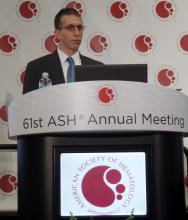ORLANDO – Preclinical research suggests nuclear factor I X is a fetal hemoglobin repressor, a finding that could have implications for the treatment of sickle cell disease.
Researchers found that knocking down nuclear factor I X (NFIX) in adult erythroblasts induced fetal hemoglobin expression in a vast majority of cells, and the total amount of fetal hemoglobin in those cells was about 40%. The target level of fetal hemoglobin for sickle cell patients to become asymptomatic is 30%, according to study investigator Jeffrey R. Shearstone, PhD, of Syros Pharmaceuticals in Cambridge, Mass. He made these remarks during a press conference at the annual meeting of the American Society of Hematology. Mudit Chaand, PhD, also of Syros, is scheduled to present the study at the meeting on Dec. 9, 2019.
“While this is obviously a preclinical, investigational study, to see levels of induction in primary cells and cell lines of 40% is very encouraging and shows that [NFIX] is a very potent fetal hemoglobin repressor,” Dr. Shearstone said. “We see this discovery as, potentially, a new avenue for therapeutic intervention in sickle cell disease, but there’s still a lot of work to be done.”
Syros researchers began this study by comparing erythroblasts derived from cord blood, which have high levels of fetal hemoglobin, and erythroblasts derived from bone marrow, which have low levels of fetal hemoglobin. The team’s goal was to identify transcription factors that might regulate the repression of fetal hemoglobin in adult cells.
Chromatin accessibility mapping pointed to NFIX as a hemoglobin repressor. The researchers observed increased accessibility at the NFIX promoter and elevated NFIX messenger RNA in adult cells.
To confirm NFIX’s role as a repressor of fetal hemoglobin, the researchers used short hairpin RNA to knock down NFIX in primary erythroblasts and cell lines.
“By knocking down NFIX, we saw a very robust induction of fetal hemoglobin,” Dr. Shearstone said. “We saw nearly 100% of cells in which NFIX was knocked down express fetal hemoglobin. This level of induction compared very favorably to probably the two most potent known repressors of fetal hemoglobin, ZBTB7A and BCL11A.”
Specifically, 86%-97% of cells with NFIX knockdown expressed fetal hemoglobin, compared with 16% of control cells, 88% of cells with BCL11A knockdown, and 91% of cells with ZBTB7A knockdown.
The total amount of fetal hemoglobin in erythroblasts with NFIX knockdown was 39%-40%.
The researchers plan to conduct additional studies to validate these results, examine how NFIX directly binds at the fetal globin promoter, determine if NFIX interacts with any previously identified fetal hemoglobin repressors, and investigate how NFIX can be shut down in patients with sickle cell disease. The researchers’ ultimate goal is to develop a small molecule that would target NFIX.
All researchers involved in this work are employees of Syros Pharmaceuticals.
SOURCE: Shearstone JR et al. ASH 2019, Abstract 821.

